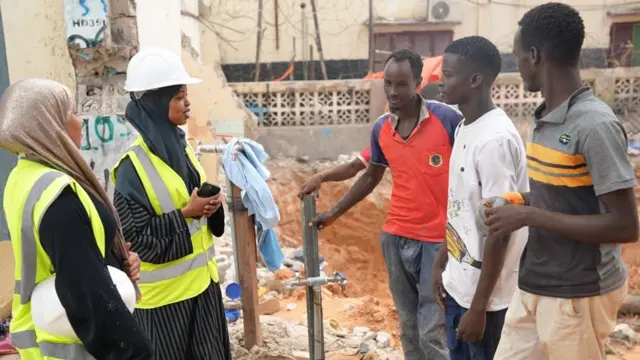The Women Powering Somalia’s Construction Boom
In the heart of the Horn of Africa, a powerful transformation is reshaping the skyline of Mogadishu, Somalia’s capital. Once synonymous with conflict and devastation, the city is now witnessing a construction boom that reflects the resilience and aspirations of a nation on the mend. At the forefront of this transformation are Somali women—architects, engineers, real estate developers, and construction workers—who are challenging traditional norms and redefining the role of women in society.
The image of women hauling bricks, drafting blueprints, managing construction firms, and leading site inspections stands in stark contrast to long-standing gender expectations in a country still grappling with the aftermath of decades of civil war. Yet, these women are not only contributing to Somalia’s rebuilding; they are laying the foundations—literally and metaphorically—of a more inclusive future.
Breaking Barriers in a Male-Dominated Industry
Historically, Somalia’s construction sector has been dominated by men. The physical demands of the job, coupled with conservative cultural norms, often relegated women to roles deemed more “appropriate” such as teaching or nursing. But over the past decade, there has been a steady shift.
One of the catalysts for this change has been the rapid urbanization in Mogadishu and other Somali cities. As peace slowly returns and diaspora communities invest in their homeland, the demand for housing, commercial infrastructure, and public buildings has surged. This booming sector, while providing jobs, also created a talent gap—one that many women have stepped in to fill.
Somali women, many of whom were previously confined to domestic spaces, are enrolling in engineering and architecture programs at local universities in increasing numbers. In Mogadishu, universities like the Somali International University and SIMAD University report a growing proportion of female students in construction-related fields. These women are bringing fresh perspectives, innovative ideas, and a deep commitment to rebuilding their communities.
Stories of Courage and Innovation
Among the leading figures in this movement is Nasra Ismail, a civil engineer who returned to Somalia from Canada in 2016. Armed with a degree and international experience, she established her own construction firm in Mogadishu. Initially, she faced skepticism from clients and colleagues alike. “Some people wouldn’t believe a woman could run a site,” she recalls. “They would ask to speak to the ‘real engineer’.”
Undeterred, Nasra took on small contracts, gradually building a reputation for quality and reliability. Today, her firm is responsible for several multi-story apartment complexes and office buildings in the capital. She also mentors young women entering the field, offering internships and workshops through her nonprofit initiative “BuildHer Somalia.”
Another remarkable figure is Ayaan Ahmed, a 29-year-old bricklayer who started working on construction sites after her husband was killed in a bombing. With three children to support, Ayaan defied cultural taboos and joined a team of male laborers. “At first, they laughed,” she says. “But now, they respect me. I’m stronger than most of them.”
Ayaan now leads a crew of female workers on a housing project funded by a Somali NGO. Her story has inspired dozens of other widows and single mothers to consider careers in construction—not as a last resort, but as a viable profession.
Economic Empowerment and Social Change
The rise of women in construction is not just a story of empowerment; it’s also a story of economic transformation. The construction sector contributes significantly to Somalia’s GDP and employs thousands across the country. With women joining the ranks, household incomes are improving, and the broader economy is becoming more resilient.
Moreover, this shift is influencing societal attitudes. As more women become financially independent and take on leadership roles, they challenge patriarchal norms that have long defined Somali gender relations. In some neighborhoods of Mogadishu, it is now common to see female-led construction teams working on public infrastructure like schools, clinics, and roads.
Local media and advocacy organizations are also playing a role in amplifying these successes. Documentaries, radio programs, and social media campaigns are highlighting the contributions of women in construction, shifting public perception and inspiring the next generation.
Challenges Remain
Despite these advances, obstacles persist. Sexual harassment, wage disparities, and limited access to capital continue to hinder women’s full participation in the industry. Many women contractors report difficulties in securing large-scale government or private contracts, as procurement processes often favor established male-run firms.
Moreover, safety remains a concern, especially in volatile areas where militant groups like Al-Shabaab continue to pose threats. Several female engineers and site workers have been targeted simply for challenging gender norms or working in public.
There is also a need for policy reform. The Somali government has yet to implement industry-wide gender equality standards or affirmative action measures in construction. Without institutional support, much of the progress remains vulnerable to reversal.
Building the Future, One Brick at a Time
Still, the determination of Somalia’s women builders remains unshaken. Their work is not only rebuilding homes and offices but also restoring dignity, hope, and possibility. These women are not waiting for change—they are constructing it brick by brick, beam by beam.
In a country where the scars of war run deep, and where recovery is as much psychological as it is physical, the sight of a woman leading a construction project is more than symbolic. It is a declaration: Somalia is rising, and its women are not just participants in that rise—they are its architects.










